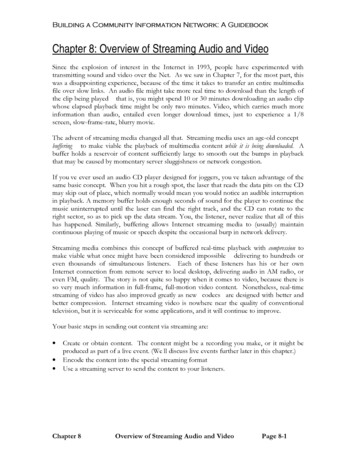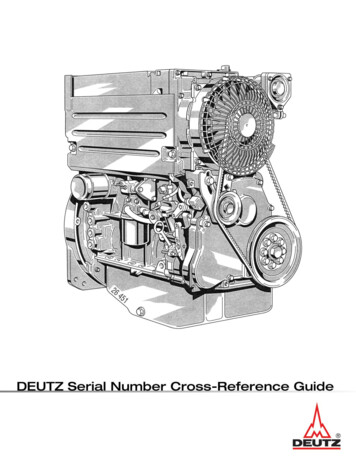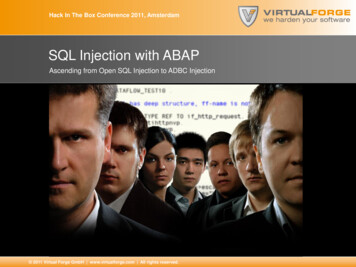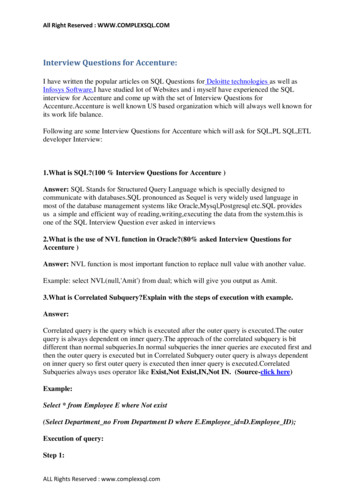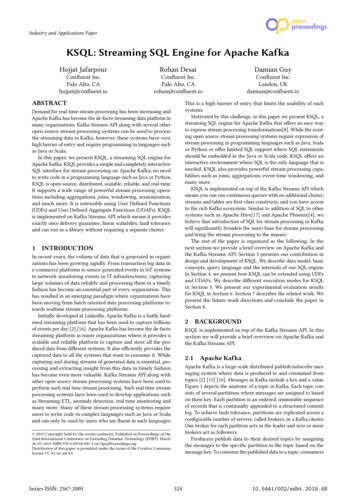
Transcription
Industry and Applications PaperKSQL: Streaming SQL Engine for Apache KafkaHojjat JafarpourConfluent Inc.Palo Alto, CAhojjat@confluent.ioRohan DesaiConfluent Inc.Palo Alto, CArohan@confluent.ioDemand for real-time stream processing has been increasing andApache Kafka has become the de-facto streaming data platform inmany organizations. Kafka Streams API along with several otheropen source stream processing systems can be used to processthe streaming data in Kafka, however, these systems have veryhigh barrier of entry and require programming in languages suchas Java or Scala.In this paper, we present KSQL, a streaming SQL engine forApache Kafka. KSQL provides a simple and completely interactiveSQL interface for stream processing on Apache Kafka; no needto write code in a programming language such as Java or Python.KSQL is open-source, distributed, scalable, reliable, and real-time.It supports a wide range of powerful stream processing operations including aggregations, joins, windowing, sessionization,and much more. It is extensible using User Defined Functions(UDFs) and User Defined Aggregate Functions (UDAFs). KSQLis implemented on Kafka Streams API which means it providesexactly once delivery guarantee, linear scalability, fault toleranceand can run as a library without requiring a separate cluster.INTRODUCTIONIn recent years, the volume of data that is generated in organizations has been growing rapidly. From transaction log data ine-commerce platforms to sensor generated events in IoT systemsto network monitoring events in IT infrastructures, capturinglarge volumes of data reliably and processing them in a timelyfashion has become an essential part of every organization. Thishas resulted in an emerging paradigm where organizations havebeen moving from batch oriented data processing platforms towards realtime stream processing platforms.Initially developed at LinkedIn, Apache Kafka is a battle hardened streaming platform that has been used to capture trillionsof events per day [2] [16]. Apache Kafka has become the de-factostreaming platform in many organizations where it provides ascalable and reliable platform to capture and store all the produced data from different systems. It also efficiently provides thecaptured data to all the systems that want to consume it. Whilecapturing and storing streams of generated data is essential, processing and extracting insight from this data in timely fashionhas become even more valuable. Kafka Streams API along withother open source stream processing systems have been used toperform such real time stream processing. Such real time streamprocessing systems have been used to develop applications suchas Streaming ETL, anomaly detection, real time monitoring andmany more. Many of these stream processing systems requireusers to write code in complex languages such as Java or Scalaand can only be used by users who are fluent in such languages.2BACKGROUNDKSQL is implemented on top of the Kafka Streams API. In thissection we will provide a brief overview on Apache Kafka andthe Kafka Streams API.2.1Apache KafkaApache Kafka is a large-scale distributed publish/subscribe messaging system where data is produced to and consumed fromtopics [2] [15] [16]. Messages in Kafka include a key and a value.Figure 1 depicts the anatomy of a topic in Kafka. Each topic consists of several partitions where messages are assigned to basedon their key. Each partition is an ordered, immutable sequenceof records that is continually appended to a structured commitlog. To achieve fault tolerance, partitions are replicated across aconfigurable number of servers, called brokers, in a Kafka cluster.One broker for each partition acts as the leader and zero or morebrokers act as followers.Producers publish data to their desired topics by assigningthe messages to the specific partition in the topic based on themessage key. To consume the published data to a topic, consumers 2019 Copyright held by the owner/author(s). Published in Proceedings of the22nd International Conference on Extending Database Technology (EDBT), March26-29, 2019, ISBN 978-3-89318-081-3 on OpenProceedings.org.Distribution of this paper is permitted under the terms of the Creative Commonslicense CC-by-nc-nd 4.0.Series ISSN: 2367-2005Confluent Inc.London, UKdamian@confluent.ioThis is a high barrier of entry that limits the usability of suchsystems.Motivated by this challenge, in this paper we present KSQL, astreaming SQL engine for Apache Kafka that offers an easy wayto express stream processing transformations[8]. While the existing open source stream processing systems require expression ofstream processing in programming languages such as Java, Scalaor Python or offer limited SQL support where SQL statementsshould be embedded in the Java or Scala code, KSQL offers aninteractive environment where SQL is the only language that isneeded. KSQL also provides powerful stream processing capabilities such as joins, aggregations, event-time windowing, andmany more.KSQL is implemented on top of the Kafka Streams API whichmeans you can run continuous queries with no additional cluster;streams and tables are first-class constructs; and you have accessto the rich Kafka ecosystem. Similar to addition of SQL to othersystems such as Apache Hive[17] and Apache Phoenix[4], webelieve that introduction of SQL for stream processing in Kafkawill significantly broaden the users base for stream processingand bring the stream processing to the masses.The rest of the paper is organized as the following. In thenext section we provide a brief overview on Apache Kafka andthe Kafka Streams API. Section 3 presents our contribution indesign and development of KSQL. We describe data model, basicconcepts, query language and the internals of our SQL engine.In Section 4, we present how KSQL can be extended using UDFsand UDAFs. We describe different execution modes for KSQLin Section 5. We present our experimental evaluation resultsfor KSQL in Section 6. Section 7 describes the related work. Wepresent the future work directions and conclude the paper inSection 8.ABSTRACT1Damian Guy52410.5441/002/edbt.2019.48
Figure 1: Anatomy of a Kafka topicFigure 3: Two consumer groups reading from a topic withfour partitions.form consumer groups where each published message will bedelivered to one instance in the consumer group. Figure 2 showstwo consumer groups that consume messages from a topic withfour partitions in a Kafka cluster with two brokers.A typical Kafka streams application will read from one or moreKafka topic and process the data and writes the results into one ormore Kafka topics. Kafka streams app uses the same data modelas Kafka where messages include a key and a value along with atimestamp and offset of the message in its corresponding partition. The processing logic in a Kafka streams app is defined as aprocessing topology that include source, stream processor andsink nodes. The processing model is one record at a time wherean input record from the source is processed by passing throughthe whole topology before the next recored is processed. Kafkastreams provides powerful stream processing capabilities suchas joins, aggregations, event-time windowing, sessionization andmore. Operations such as join and aggregation are done based onthe message key. Kafka streams uses intermediate Kafka topicsto perform shuffle for operations such as aggregation and jointhat need to colocate data based on a key. For instance, if twostreams are being joined and the join key is not the same as themessage key for both streams, Kafka streams repartitions bothstream topics based on the join key and produces new intermediate topics where message key is the same as the join. This willensure the colocation of the records with the same key that canbe joined at the same node.Kafka streams provides stateful stream processing throughthe so-called state stores. The state stores exist in every instanceof the streaming application and are used to store the state inoperations such as join and aggregation in a distributed fashion.By default Kafka streams uses RocksDB[9] to store applicationstate, however, any in-memory hash map or other data structurescan be plugged in.Figure 2: Two consumer groups reading from a topic withfour partitions.A consumer groups can expand by adding more members toit. It can also shrink when group members fail or are removedexplicitly. Whenever, a consumer group changes, Kafka clusterwill go through a rebalancing process for the consumer group toguarantee every partition in the topic will be consumed by oneinstance in the consumer group. This is done by Kafka groupmanagement protocol which is one of the fundamental buildingblocks of the Kafka streams API as we describe below.2.2Kafka Streams APIKafka Streams API is a Java library that enables users to writehighly scalable, elastic, distributed and fault-tolerant stream processing applications on top of Apache Kafka [2]. Unlike otherstream processing frameworks that need a separate computecluster to run stream processing jobs, Kafka streams runs as anapplication. You can write your stream processing applicationand package it in your desired way, such as an executable jar file,and run instances of it independently. If you need to scale outyour application, you just need to bring up more instances of theapp and Kafka streams along with Kafka cluster will take careof distributing the load among the instances. The distribution ofload in Kafka streams is done with the help of Kafka group management protocol. Figure 3 depicts the architecture of a Kafkastreams app.3KSQLIn this section we present KSQL, streaming SQL engine for Kafka.As mentioned KSQL uses Kafka streams to run the user queries,therefore, it inherits many properties of Kafka streams.3.1Data ModelAs mentioned a message in a Kafka topic consists of a key anda value. To keep the messages generic, Kafka does not assumeany specific format for the messages and both key and valueare treated as array of bytes. In addition to the key and value, amessage also includes a timestamp, a partition number that itbelongs to and the offset value in the corresponding partition. In525
order to use SQL on top of Kafka topics we need to impose therelational data model, schema, on the value part of messages inKafka topics. All of the message values in a topic should conformto the associated schema to the topic. The schema defines amessage value as a set of columns where each column conformsto the defined data type. Currently, we support the primitivetypes of BOOLEAN, INTEGER, BIGINT, DOUBLE and VARCHARalong with the complex types of ARRAY, MAP and STRUCT. Weplan to add DECIMAL, DATE and TIME types in future. KSQLsupports nested column type using the STRUCT type. The fieldsin a ARRAY, MAP and STRUCT types themselves can be any ofthe supported types including complex types. As you can see,there is no limit in the level of nesting and users can have asmany levels of nesting as they desire. The schema of messagevalues for Kafka topic is used for serialization and deserializationof message values.3.2requires a sliding window since we should prevent the size of thestate store growing indefinitely. Every time a new message arrivesto either of the streams, the join operation will be triggered andthe new message for each matching message from the otherstream within the join window will be produced. KSQL supportsINNER, LEFT OUTER and FULL OUTER join operations for twostreams. The RIGHT OUTER join can be implemented via theLEFT OUTER join by simply change the left and right sides of thejoin. Joining a stream with a table is a stateless operation whereeach new message in the stream will be matches with the tableresulting in emission of zero or one message. Finally, joiningtwo tables in KSQL is consistent with joining them in relationaldatabases if we materialize both of them. KSQL supports INNER,LEFT OUTER and FULL OUTER joins for two tables.3.3Query LanguageKSQL query language is a SQL-like language with extensions tosupport stream processing concepts. Similar to the standard SQLlanguage, we have DDL and DML statements. DDL statementsare used to create or drop streams or tables on top of existingKafka topic. The followings are two DDL statements to create apageviews stream and a users table:Basic ConceptsKSQL provides streaming SQL for Kafka topics meaning thatyou can write continuous queries that run indefinitely queryingfuture data. There are two basic concepts in KSQL that users canuse in their queries, stream and table. Depending on how weinterpret the messages in a Kafka topic we can define streams ortables over Kafka topics in KSQL.If we consider the messages arriving into a topic as independent and unbounded sequence of structured values, we interpretthe topic as a stream. Messages in a stream do not have anyrelation with each other and will be processed independently.On the other hand, if we consider the messages arriving into atopic as an evolving set of messages where a new message eitherupdates the previous message in the set with the same key, oradds a new message when there is no message with the samekey, then we interpret the topic as a table. Note that a table is anstate-full entity since we need to keep track of the latest valuesfor each key. In other words, if we interpret the messages in atopic as a change log with a state store that represent the lateststate, then we interpret the topic as a table.As an example consider we store the page view events for awebsite in a Kafka topic. In this case, we should interpret thetopic as a stream since each view is an independent message. Onthe other hand, consider we are storing user information is aKafka topic where each message either adds a new user if it isnot stored already or updates the user information if we alreadyhave stored the user. In this case, we should interpret the topicas a table. Note that at any moment, the table should have themost up to date information for every user.KSQL also provides windowed stream processing where youcan group records with the same key to perform stateful processing operations such as aggregations and joins. Currently, KSQLsupports three types of windows:CREATE STREAM pageviews (viewtime BIGINT,userid VARCHAR, pageid VARCHAR) WITH(KAFKA TOPIC 'pageviews topic',VALUE FORMAT 'JSON');CREATE TABLE users (registertime BIGINT,gender VARCHAR,regionid VARCHAR,userid VARCHAR,address STRUCT street VARCHAR, zip INTEGER ) WITH (KAFKA TOPIC 'user topic',VALUE FORMAT 'JSON',KEY 'userid');Note that in addition to defining the schema for the streamor table we need to provide information on the Kafka topic andthe data format in the WITH clause. After declaring streams andtables, we can write continuous queries on them.Unlike standard SQL statements where the queries return finite set of records as the result, in streaming systems we havecontinuous queries and therefore the results also will be continuous while the query runs. To address this, KSQL providestwo types of query statements. If the results of the query arestored as a new stream or table into a new Kafka topic we useCSAS(CREATE STREAM AS SELECT) , CTAS(CREATE TABLE AS SELECT) or INSERT INTO statements depending onthe type of the query results. For instance, the following statement enriches the pageviews stream with extra user informationby joining it with the users table and only passes the recordswith regionid ’region 10’. The result is a new stream that wecall enrichedpageviews: Tumbling window which are time-based, fixed-sized,non-overlapping and gap-less windows Hopping window which are time-based, fixed-sized andoverlapping windows Session window which are session-based, dynamicallysized, non-overlapping and data-driven windowsNote that the results of windowed aggregations are tables inKSQL where we need to keep the state for each window andaggregation group and update them upon receiving new values.KSQL also support join operation between two streams, astream and a table or two tables. The stream-stream join alwaysCREATE STREAM enrichedpageviews ASSELECT * FROM pageviews LEFT JOINusers ON pageviews.userid users.useridWHERE regionid 'region 10';526
such as map, join, filter, aggregate, etc that convert KStreams/KTables into new KStream/KTables. These operations work on keyand value of Kafka messages where there is no assumption onthe schema of message value. KSQL defines similar operationson streams and tables, however, in KSQL we impose the properschema on the message value.KSQL engine also is responsible for keeping the metastoreand queries in the correct state. This includes rejecting statements when they result in incorrect state in the engine. Droppingstreams or tables while there are queries that are reading fromor writing into them is one of the cases that would result thesystem to go into an incorrect state. A stream or table can onlybe dropped if there is no query reading from or writing into it.KSQL engine keeps track of queries that read from or write into astream or table in the metastore and if it receives a DROP statement for s stream or table that is still being used, it will reject theDROP statement. Users should make sure that all of the queriesthat use a stream or table are terminated before they can dropthe stream or table.On the other hand, the following CTAS statement creates atable that contains the pageviews for each user in every 1 hour.Here we use an aggregate query with tumbling window with sizeof 1 hour.CREATE TABLE userviewcount ASSELECT userid, count(*)FROM pageviewsWINDOW TUMBLING (SIZE 1 HOUR)GROUP BY useid;Note that the results of the above query will be continuouscount values for each user and window that will be stored ina Kafka topic. Every time we receive a new record the currentcount value for the corresponding userid and window will beupdated and the new updated value will be written to the topic.As it can be seen the result will be a change log topic.Depending on the execution model that we will discuss in thelater section, KSQL also provides query manipulation statementswhere user can submit continuous queries, list the currentlyrunning continuous queries and terminate the desired ones.3.44UDFS AND UDAFSAlthough standard SQL statements provide a good set of capabilities for data processing, many use cases need to perform morecomplex and custom operation on data. By using functions inqueries SQL systems enhance their data processing capabilities.KSQL also provide an extensive set of built in scalar and aggregate functions that can be use in queries. However, to even makeKSQL more extensible, we have added capability of adding custom User Defined Functions (UDFs) and User Defined AggregateFunctions (UDTFs).KSLQ EngineAs mentioned, KSQL uses Kafka streams to run the streamingqueries. The main responsibility of the KSQL engine is to compilethe KSQL statements into Kafka streams apps that can continuously run and process data streams in Kafka topics. To achievethis KSQL has a metastore component that acts as a system catalog storing information about all the available streams and tablesin the system. Currently metastore is an internal component inthe KSQL engine. Depending on the execution mode the metastore can be backed by a Kafka topic to provide fault tolerance.Figure 4 depicts the steps that are taken in the engine to compile KSQL statements into Kafka streams applications to run. Asit can be seen, the first step is to parse the statements where theKSQL parser generates an Abstract Syntax Tree (AST). Usingthe metastore, the generated AST will be analyzed and the unresolved columns references will be resolved. This include detectingthe column types along with resolving expression types in thequeries along with extracting different components of a queryincluding source, output, projection, filters, join and aggregation.After analyzing each query, we will build a logical plan for it.Logical plan is a tree structure where the nodes are instancesof PlanNode class. Currently, we can have the following nodetypes in KSQL logical plan: SourceNode, JoinNode, FilterNode,ProjectNode, AggregateNode and OutputNode. The leaf node(s)are of SourceNode type and the root node is OutputNode type. Asit is indicated in Figure 4. rule-based optimization techniques canbe applied to the generated logical plan, however, at the momentwe do not apply any rule to the logical plan other than pushingdown the filters.The final step is to generate a physical execution plan from thelogical plan. The physical plan in KSQL is a Kafka streams topology that runs the stream processing logic. We use the higher leveltopology structure that is called Kafka streams DSL[2]. Kafkastreams defines two fundamental building blocks, KStream andKTable which are synonymous to stream and table in KSQL. Indeed, A KSQL stream represents a KStream along with a schema.Similarly, a KSQL table represents a KTable along with the associated schema. Kafka streams DSL also provides operations4.1User Defined FunctionsUDF functions are scalar functions that take one input row andreturn one output value. These functions are stateless, meaningthere is no state is maintained between different function calls.Currently, KSQL supports UDFs written in Java. Implementinga new UDF is very straightforward using only two annotations.A Java class annotated by @UdfDescription annotation will beconsidered as a UDF containing class. User provide the name ofthe UDF by setting the name parameter of the @UdfDescriptionannotation. Any function in this class that is annotated by @Udfannotation will be considered as a UDF that can be used in anyquery similar to any other built in function. The following is anexample UDF that implements multiplication.@UdfDescription(name "multiply", description "multiplies 2 numbers")public class Multiply {}@Udf(description "multiply two non-nullable INTs.")public long multiply(final int v1, final int v2) {return v1 * v2;}After implementing the UDFs, users can package them in aJAR file and upload it to the designated directory in the KSQLengine where the functions will be loaded from when the KSQLengine starts up. The following query shows how the above UDFcan be used in a query:CREATE STREAM test ASSELECT multiply(col1, 25)527
Figure 4: Steps to convert KSQL statements into Kafka streams apps.FROM inputStream;4.25.1User Defined Aggregate FunctionsAggregate functions are applied to a set of rows and computea single value for them. Similar to the UDFs, KSQL UDAFs areimplemented in Java using annotations. To create a new UDAF,users need to create a class that is annotated with @UdafDescription. Methods in the class that are used as a factory for creating anaggregation must be public and static, be annotated with @UdafFactory, and must return an instance of Udaf class. The instancesof a textitUdaf class should implement initialize, aggregate andmerge methods. The following is an example UDAF that willperform sum operation over double values:5.2@UdafDescription(name "my sum", description "sums")public class SumUdaf {@UdafFactory(description "sums double")public static Udaf Double, Double createSumDouble() {return new Udaf Double, Double () {@Overridepublic Double initialize() {return 0.0;}}@Overridepublic Double merge(final Double aggOne, finalDouble aggTwo) {return aggOne aggTwo;}};Similar to UDFs, UDAFs should be packaged in a JAR file anduploaded to the designated folder in the KSQL engine so thefunctions can be loaded at the engine start up.We plan to add support for User Defined Table Functions(UDTFs) in near future.5Interactive ModeKSQL also provides an interactive execution mode where userscan interact with a distributed service through a REST API. Oneway of using the provided REST API is to use KSQL CLI whichincludes a REST client that sends user requests to the serviceand receives the response. The building block of the interactivemode is KSQL server that provides a REST end point for usersto interact with the service and also KSQL engine to execute theuser queries. Figure 5 depicts the architecture of the KSQL servicewith three servers in the interactive client-server execution mode.Each KSQL server instance includes two components, theKSQL engine and the REST server. The KSQL service uses a special Kafka topic, KSQL command topic, to coordinate amongthe service instances. When a service instance is started, it firstchecks the Kafka cluster for the command topic. If the topic doesnot exists it creates a new command topic with a single partition and a configurable number of replications. All of the serviceinstances then subscribe to the command topic. User interactswith the service by connecting to REST endpoint on one of theinstances. The KSQL command topic has only one partitionto ensure the order of KSQL statements for all server is exactlythe same. The KSQL command topic can have more than onereplicas to prevent loss of KSQL statements in presence of failure.The figure shows the KSQL CLI that connects to either of theinstances.When user submits a new KSQL statement through the RESTendpoint, the instance that receives the request will append it tothe KSQL command topic. The KSQL engine components in all ofthe instances will pull the new statement from the command topicand execute the statement concurrently. For instance, considerthe following statement is submitted to the service through oneof the instances and appended to the command topic.CREATE TABLE userviewcount ASSELECT userid, count(*)FROM pageviews@Overridepublic Double aggregate(final Double aggregate,final Double val) {return aggregate val;}}Application ModeThe application mode is very similar to running a Kafka streamsapp as described earlier. To deploy and run your queries, youneed to put them in a query file and pass it as an input parameterto the KSQL executable jar. Depending on the required resources,you determine the number of instances that your applicationneeds and similar to a Kafka streams execution model you willinstantiate the instances by running the KSQL jar with the queryfile as input parameter. The deployment process can be done manually or through third party resource managers such as Mesos[3]or Kubernetes[10]. Note that you don’t need any extra processing cluster and the only thing you need is to run your KSQLapp by bringing up desired number of instances independently.Everything else will be handled by KSQL and Kafka streams.EXECUTION MODESAs discussed above, KSQL engine creates Kafka streams topologies that execute the desired processing logic for Kafka topics.Therefore, running KSQL queries is the same as running Kafkastreams topologies. Currently, KSQL provides three different execution modes that we describe here.528
application. As mentioned Kafka streams apps are Java programsthat use the Kafka streams as library. KSQL provides a KSQLContext class with a sql() method where KSQL statements canbe passed to run in the embedded engine. The following codesnippet show a very simple example of using the embedded mode.KSQLContext ksqlContext new KSQLContext();ksqlContext.sql("CREATE STREAM pageviews(viewtime BIGINT, userid VARCHAR,pageid VARCHAR) WITH(KAFKA TOPIC 'pageviews topic',VALUE FORMAT 'JSON');");ksqlContext.sql("CREATE STREAM pageviewfilterAS SELECT * FROM pageviewsWHERE userid LIKE '\%10';");Similar to the Kafka streams apps, in order to execute thequeries in the embedded mode, you need to package the application and run instances of it. The deployment can be donethrough a range of available options such as manually bringingup instances or using more sophisticated tools such as Mesos orKubernetes.6 EXPERIMENTAL EVALUATION6.1 MethodologyWe want to evaluate KSQL’s ability to handle different types ofworkloads. To do this, we ran a series of tests with different querytypes and measured the throughput that a single KSQL servercan process. Each test case runs for ten minutes and periodicallymeasures throughput in messages / second and bytes / second.In practice, users will likely run multiple queries that feedinto each other to form a streaming pipeline. We’ve included amulti-query test to measure performance for this scenario.Finally, we run multiple queries on a pool of KSQL nodes tosee how KSQL scales as servers are added.Figure 5: A KSQL interactive service deployment withthree server instances.WINDOW TUMBLING (SIZE 1 HOUR)GROUP BY useid;All of the instances will use the KSQL engine to start theprocessing of the query and as mentioned above each instancewill process portion of the input data from the pageviews topic.The service instances continue running the queries until they areexplicitly terminated using TERMINATE statement.The KSQL service provides both elasticity and fault tolerance.Service instances can be added or removed independently, depending on the load and performance requirements. When a newinstance is started it subscribes to the command topic and fetchesall the existing KSQL statements from the command topic andstarts executing them. When the new instance starts executingan existing query a rebalance process is triggered and the execution load will be redistributed among the existing instances. Notethat the rebalance protocol is handled by the underlying Kafkaconsumers in the Kafka streams and is transparent for the KSQLservice instance. After all of the existing continuous queries startrunning on the new instance too, it starts listening to the command topic for new queries. Similarly when an instance fails orterminated a rebalance process among the remaining instancesof the service happens and the load of the removed instance willbe distributed among the remaining instances. Even if all theinstances fail and the whole system is restarted, the instanceswill pick up all the existing KSQL queries from the commandtopic when they come back online and the whole system willcontinue processing the queries from the po
section we will provide a brief overview on Apache Kafka and the Kafka Streams API. 2.1 Apache Kafka Apache Kafka is a large-scale distributed publish/subscribe mes-saging system where data is produced to and consumed from topics [ 2] [15 ] [16 ]. Messages in Kafka include a key and a value. Figure 1





